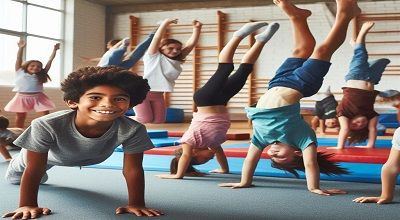Educational Gymnastic
Educational gymnastics is a form of physical education focusing on how individuals can use movement to explore and express themselves. It’s not about competition or showing off athletic skills; instead, it’s a learning process where students discover what their bodies are capable of in a safe and supportive environment. Here are the kinds and importance of educational gymnastics:
Kinds of Educational Gymnastics
- Locomotor Skills Gymnastics: This involves movements that help a person move from one place to another. Examples include walking, running, jumping, and skipping. It’s about teaching the basics of movement and coordination.
- Non-locomotor (Static) Skills Gymnastics: These are movements performed without traveling. Think of balancing, twisting, bending, and stretching. These activities help improve flexibility and control over one’s body.
- Manipulative Skills Gymnastics: This includes activities where you manipulate objects like ropes, balls, or hoops. It’s about developing hand-eye coordination and understanding how to control objects while moving.
Importance of Educational Gymnastics
- Physical Development: Gymnastics helps improve strength, flexibility, balance, and coordination. Regular practice can lead to better physical fitness and agility.
- Cognitive Development: It’s not just about the body. Educational gymnastics also challenges the mind. Planning and executing movements require concentration, problem-solving, and creativity.
- Emotional Development: Participating in gymnastics can boost self-esteem and confidence. It provides a safe space for students to express themselves, take risks, and overcome fears.
- Social Development: It often involves working in pairs or groups, fostering teamwork and communication skills. Students learn to trust and support one another.
Final Conclusion
Educational gymnastics isn’t about becoming an Olympic athlete; it’s a tool for overall development. It’s inclusive, meaning everyone, regardless of their athletic ability, can participate and benefit. By integrating it into the curriculum, schools provide students with a holistic approach to learning, ensuring they grow not just intellectually but physically and emotionally too. Whether it’s a simple balance activity or a complex sequence of movements, the focus is on personal growth and self-discovery.
